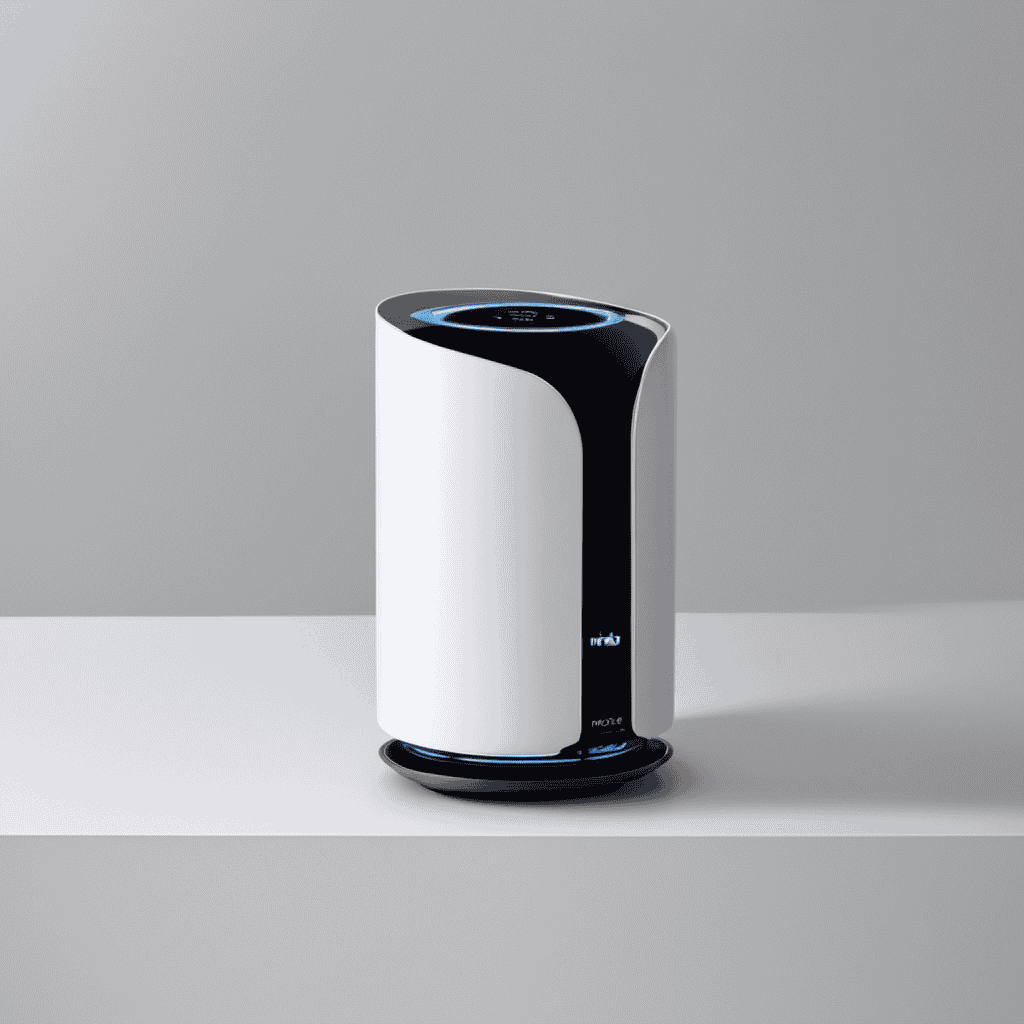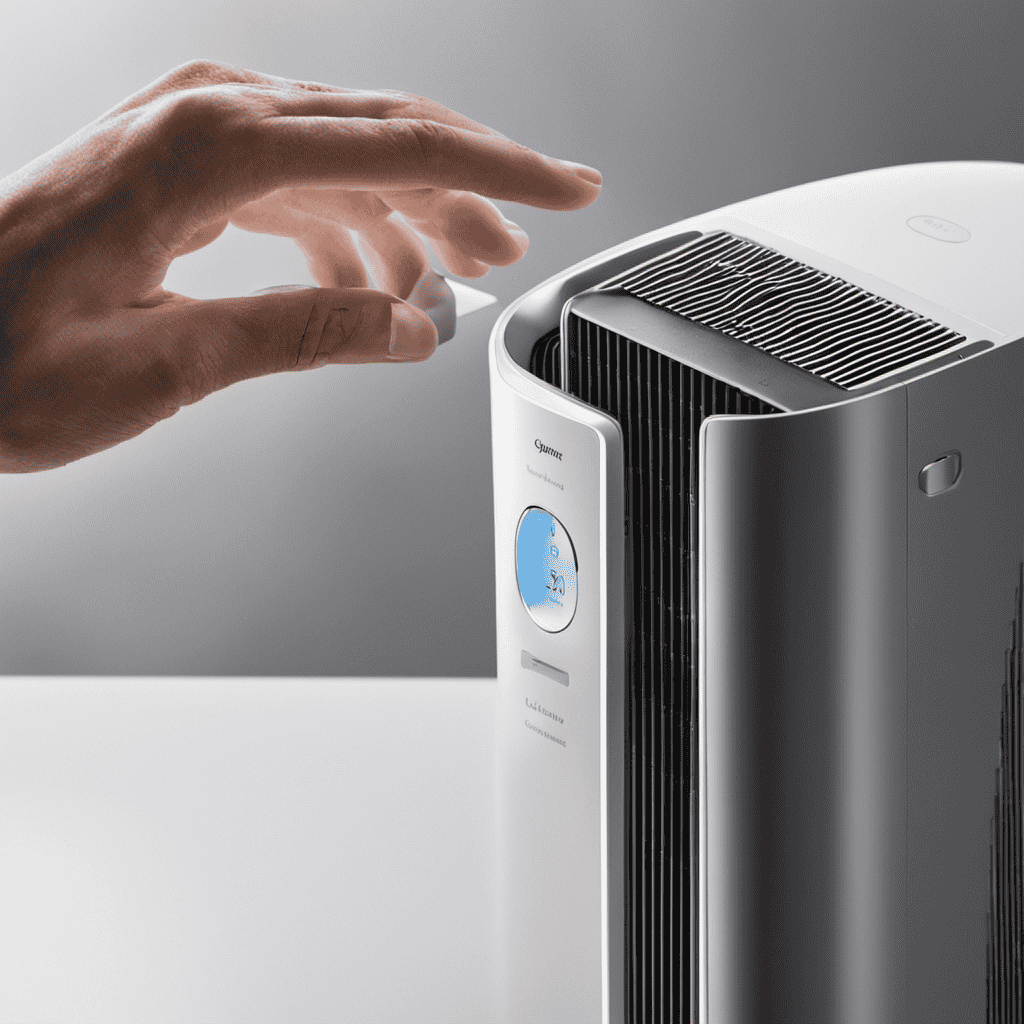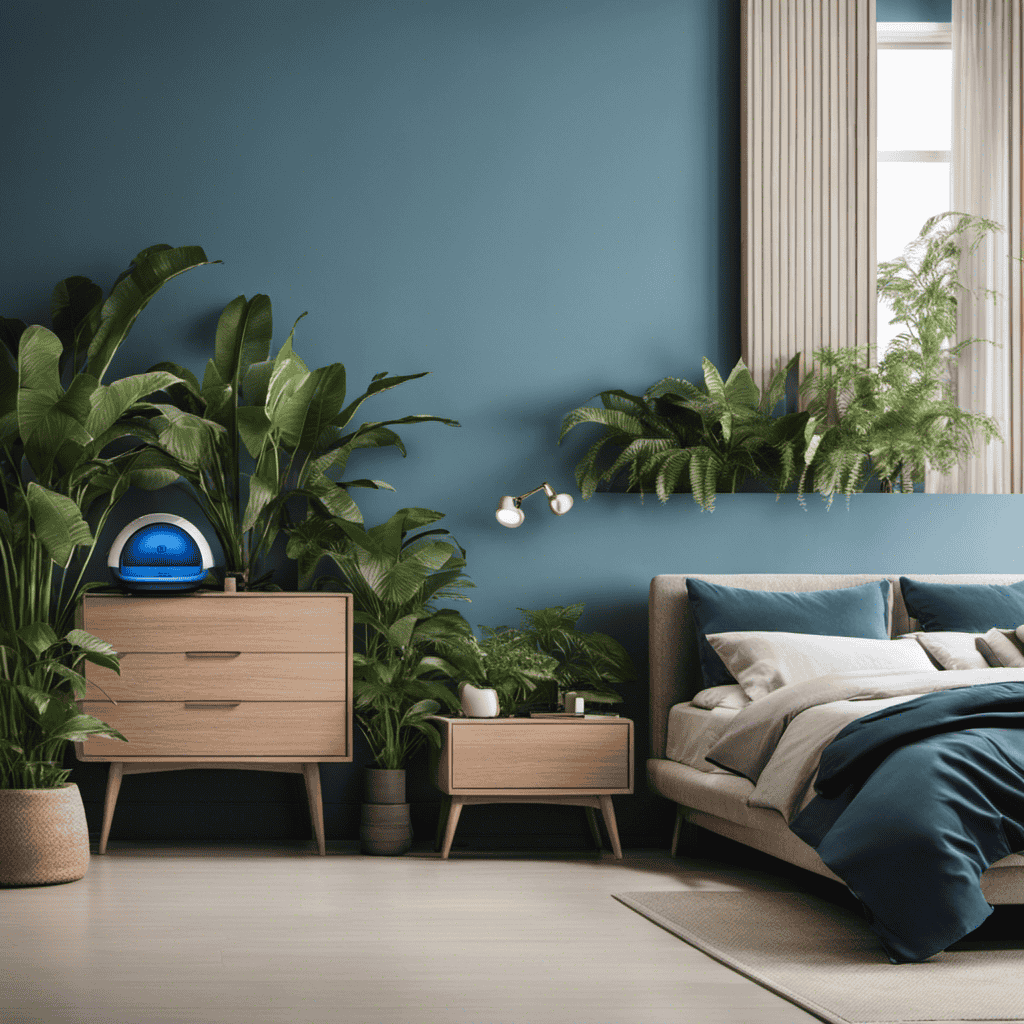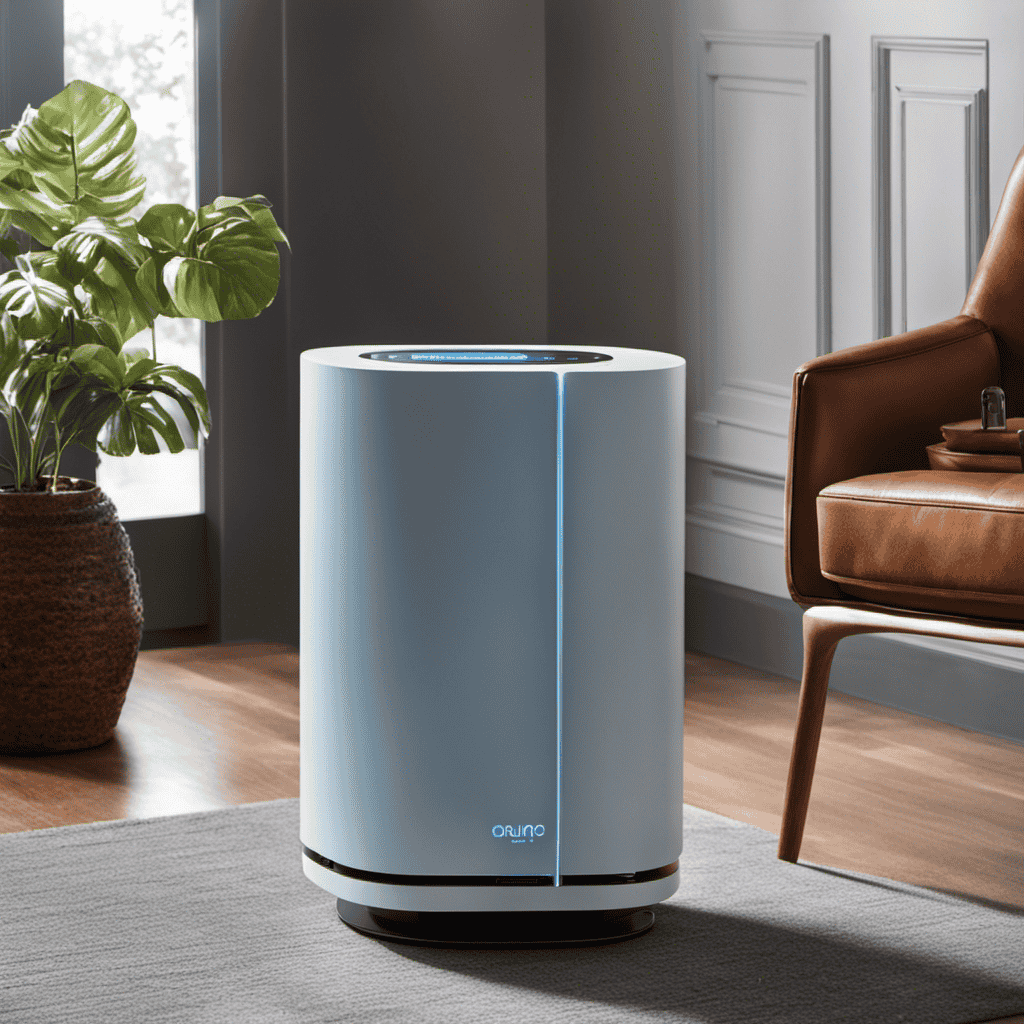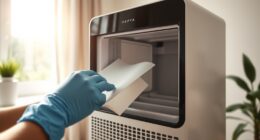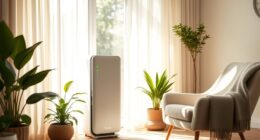I have a solution for those experiencing issues with their Mooka Air Purifier. In this article, I will demonstrate the steps on how to reset it.
Whether you need to reset the timer function, sleep mode, fan speed settings, or the ionizer function, I’ve got you covered.
By following these step-by-step instructions, you’ll have your Mooka Air Purifier back up and running in no time.
So, let’s dive in and get your air purifier working like new again!
Key Takeaways
- Resetting the Mooka air purifier resolves issues such as frozen display or unresponsive buttons.
- Disconnecting the power supply before resetting is crucial to avoid incomplete resets or potential damage.
- Holding down the reset button for at least 10 seconds ensures a successful reset.
- Resetting restores the purifier to its default settings, erasing previous configurations.
Understanding the Reset Process
To reset the Mooka air purifier, you’ll need to follow a specific process. Understanding the reset benefits and avoiding common reset mistakes is crucial.
Resetting the air purifier can help resolve issues such as a frozen display, unresponsive buttons, or error messages. It restores the purifier to its default settings, erasing any previous configurations.
One common mistake users make is not disconnecting the power supply before initiating the reset process. This can lead to incomplete resets or potential damage to the device. Another mistake is not holding down the reset button for the recommended duration. It is essential to hold it for at least 10 seconds to ensure a successful reset.
Now that you understand the reset process, let’s move on to the next step of powering off the Mooka air purifier.
Powering Off the Mooka Air Purifier
When you’re ready to turn off the Mooka air purifier, simply press the power button.
Follow these steps to troubleshoot power issues or if you’re experiencing a power button malfunction:
-
Check the power source: Ensure that the air purifier is properly plugged into a functioning electrical outlet. Verify that the power cord is securely connected.
-
Reset the circuit breaker: If the air purifier suddenly stops working, check the circuit breaker or fuse box to see if the breaker has tripped or the fuse has blown. Reset or replace as necessary.
-
Contact customer support: If the power button continues to malfunction or the air purifier does not power off, it may require professional assistance. Reach out to the Mooka customer support team for further troubleshooting guidance.
Now that you have tried troubleshooting power issues, let’s move on to locating the reset button.
Locating the Reset Button
When it comes to resetting the Mooka Air Purifier, one of the key steps is locating the reset button.
The reset button is an essential component that allows users to restore the purifier to its default settings.
In this discussion, I’ll guide you through the process of finding the reset button and effectively resetting your Mooka Purifier.
Reset Button Location
The reset button’s location can be easily found on the Mooka air purifier. It is conveniently located on the back panel of the device, near the power cord.
To reset the timer function, follow these simple steps:
- Locate the reset button on the back panel of the Mooka air purifier.
- Press and hold the reset button for 10 seconds.
- Release the reset button when you see the timer on the display reset to zero.
Troubleshooting reset problems:
- Ensure that the Mooka air purifier is plugged into a power source.
- Check if the power cord is securely connected to the device.
- If the reset button does not work, try unplugging the device from the power source, waiting for a few minutes, and then plugging it back in.
Finding Reset Button
You can easily locate the reset button on the back panel of the Mooka air purifier. To reset the air purifier, first, unplug it from the power source. Then, locate the reset button on the back panel, usually near the power cord. Press and hold the reset button for about 10 seconds. After releasing the button, plug the air purifier back into the power source. The reset process is now complete.
If you are experiencing any issues while resetting the air purifier, there are a few troubleshooting steps you can try. Firstly, make sure that the power source is working properly by plugging another device into the same outlet. If the issue persists, check if the power cord is securely connected to both the air purifier and the power source. Additionally, ensure that the air purifier is not in sleep mode or any other mode that may prevent the reset from taking place.
If these steps do not resolve the issue, consult the user manual or contact the manufacturer for further assistance.
Resetting Mooka Purifier
After locating the reset button on my Mooka air purifier, I now need to understand the benefits of resetting and troubleshoot any errors that may occur during the process. Here’s what I’ve learned:
Understanding Reset Benefits:
- Resetting the air purifier helps restore it to its original factory settings.
- It clears any stored data or settings that may be causing performance issues.
- It allows the purifier to recalibrate and optimize its functions for better air quality.
Troubleshooting Reset Errors:
- If the purifier doesn’t reset, ensure it is plugged in and powered on.
- Check the user manual for specific reset instructions or contact customer support.
- If the purifier continues to have issues after resetting, consider seeking professional assistance.
Pressing and Holding the Reset Button
To reset the Mooka air purifier, start by pressing and holding the reset button. This simple action can help resolve various issues and bring your purifier back to its optimal performance. Understanding the reset benefits and troubleshooting reset complications are essential for maintaining the functionality of your air purifier.
Here is a table that provides a clear overview of the reset button and its functions:
| Button | Function | Duration |
|---|---|---|
| Reset Button | Resets the air purifier | Hold for 5 seconds |
Release the Reset Button
After pressing and holding the reset button on my Mooka air purifier, I can now release it to complete the reset process. It is important to understand the reset steps, especially when resetting after a power outage.
Here are the steps to release the reset button:
- Ensure that the power is still connected to the air purifier.
- Hold the reset button for approximately 10 seconds until the indicator light starts flashing.
- Release the reset button and wait for the air purifier to restart.
By following these steps, you can effectively reset your Mooka air purifier and restore it to its default settings. This is particularly helpful after a power outage, as it allows the air purifier to recalibrate and resume its normal operation.
Remember to consult the user manual for specific instructions related to your Mooka air purifier model.
Confirming the Reset
You can verify that the reset process was successful by checking if the indicator light is no longer flashing. If the indicator light remains steady or turns off completely, it means that the reset has been confirmed.
However, if the light continues to flash, it indicates that there might have been an error during the reset process. In such cases, troubleshooting reset errors is necessary.
To troubleshoot, first, make sure that you followed the reset instructions correctly. Double-check if you held the reset button for the specified duration and released it at the right time.
If the error persists, try performing the reset again. If the problem still persists, consult the user manual or contact customer support for further assistance.
Resetting the Filter Life Indicator
When it comes to resetting the filter life indicator on your air purifier, there are a few key points to keep in mind.
First, it’s important to understand how to properly reset the indicator to ensure accurate readings.
However, there may be instances where the indicator does not reset as expected, leaving you wondering what to do next.
In such cases, you can refer to the manual reset instructions provided by the manufacturer for guidance.
Resetting Filter Indicator
To reset the filter indicator on your Mooka air purifier, simply press and hold the reset button for five seconds. This will clear the current filter usage data and reset the indicator to zero.
It is important to reset the filter indicator after replacing the filter to ensure accurate tracking of filter life. Here are the steps to reset the filter indicator:
- Locate the reset button on your Mooka air purifier.
- Press and hold the reset button for five seconds.
- Release the reset button when the filter indicator light blinks or turns off.
By following these steps, you can easily reset the filter indicator on your Mooka air purifier and ensure that the maintenance schedule is accurate.
Additionally, clearing the error codes will help you maintain optimal performance and prolong the lifespan of your air purifier.
Indicator Not Resetting
If the indicator isn’t resetting, try pressing and holding the reset button for a longer duration. This is a common troubleshooting step for indicator issues. Sometimes, a quick press might not be enough to reset the indicator.
By holding the reset button for a few seconds, you can ensure that the indicator is properly reset.
Additionally, if the indicator still doesn’t reset after trying this, it could be an indication of a power issue. In such cases, check if the air purifier is properly plugged into a functioning power outlet. Also, make sure that the power button is turned on.
If the indicator issue persists even after these troubleshooting steps, it may be necessary to follow the manual reset instructions. These instructions provide a detailed guide on how to reset the air purifier’s indicator.
Manual Reset Instructions?
For the manual reset instructions, you can consult the user manual that came with your device. However, if you’re having trouble finding the manual or it doesn’t provide clear instructions, there are alternative reset methods you can try. Here are three options:
-
Power cycle: Disconnect the power cord from the air purifier and wait for about 10 seconds before plugging it back in. This can sometimes resolve minor issues and restore the purifier to its default settings.
-
Button combination: Some air purifiers have specific button combinations that can trigger a manual reset. Check the user manual or manufacturer’s website for the correct combination to use.
-
Contact customer support: If the above methods don’t work or you’re unsure about attempting a manual reset, reach out to the manufacturer’s customer support for guidance and assistance.
Now, let’s move on to the next section about restoring factory settings.
Restoring Factory Settings
Simply press and hold the reset button to restore your Mooka air purifier to its factory settings. Restoring default settings is a straightforward process that ensures your air purifier functions optimally.
When you reset your Mooka air purifier, it not only reverts back to its original settings but also clears any customized preferences you may have set. This is particularly useful if you want to start fresh or if you are experiencing issues with the device.
Additionally, resetting the air quality sensor can also be done through the same reset button. By doing so, you can recalibrate the sensor and ensure accurate readings of the air quality in your environment.
Restoring factory settings and resetting the air quality sensor are essential steps in maintaining the performance and accuracy of your Mooka air purifier.
Troubleshooting Reset Issues
When it comes to resetting your mooka air purifier, it can be frustrating when the reset function is not working as expected.
In this discussion, we will explore the common issues that can prevent the reset from functioning properly and provide troubleshooting steps to resolve these problems.
Reset Not Working
If the reset button isn’t working, try unplugging the Mooka air purifier and plugging it back in. This can often resolve common reset issues.
Here are some troubleshooting steps to help you with reset failures:
-
Check the power source: Ensure that the air purifier is properly connected to a working power outlet. Sometimes, a loose or faulty connection can prevent the reset button from functioning correctly.
-
Allow time for power discharge: After unplugging the air purifier, wait for at least 30 seconds to allow any residual power to discharge. This can help reset the internal components and resolve any temporary issues.
-
Reset the circuit breaker: If the reset button still isn’t working, check the circuit breaker for your power outlet. Reset it by turning it off and then back on.
Troubleshooting Reset Problems
To troubleshoot reset problems, start by checking the power source and ensuring a proper connection to a working outlet. If the air purifier is not resetting properly, it could be due to a power issue. Make sure that the power cord is securely plugged into both the air purifier and the outlet.
If the power source is confirmed to be working, the next step is to perform a manual reset. Locate the reset button on the air purifier and press and hold it for a few seconds. This should reset the device and resolve any issues.
If the problem persists, refer to the user manual for further troubleshooting solutions.
Now, let’s move on to resetting the Wi-Fi connection.
Resetting the Wi-Fi Connection
Resetting the Wi-Fi connection on the Mooka air purifier is simple and can be done in just a few steps. If you are having trouble connecting to your Wi-Fi network or need to reset the device password, follow these steps:
-
Power off the Mooka air purifier by unplugging it from the power source.
-
Locate the reset button on the back of the device and press it using a small, pointed object like a paperclip.
-
Hold the reset button for about 10 seconds until the Wi-Fi indicator light starts flashing rapidly.
Once the Wi-Fi indicator light stops flashing and remains solid, it means that the Wi-Fi connection has been reset successfully. You can then proceed to set up the Wi-Fi connection again by following the instructions in the user manual or using the Mooka mobile app.
Resetting the Child Lock Feature
When it comes to the child lock feature on the Mooka air purifier, understanding how to activate it and reset it without the manual is crucial.
Activating the child lock ensures that young children cannot tamper with the settings or accidentally turn off the purifier.
However, if you find yourself needing to reset the child lock without the manual, it’s important to know the proper steps to do so.
Child Lock Activation
The child lock feature on the Mooka air purifier can be activated to prevent accidental button presses. This feature is especially useful when you have young children at home who might unknowingly tamper with the air purifier settings.
If you encounter any issues with the child lock feature, here are some troubleshooting steps to follow:
-
Ensure that the child lock is properly activated by checking the display panel for the lock symbol.
-
If the child lock is not working, try disabling and reactivating it by pressing and holding the designated button for a few seconds.
-
If the issue persists, refer to the user manual for further instructions or contact Mooka customer support for assistance.
Now that we have covered the child lock activation and troubleshooting, let’s move on to the next section about resetting the Mooka air purifier without a manual.
Resetting Without Manual
If you don’t have the manual, you can easily perform a reset on your Mooka air purifier by following these steps.
To reset the air purifier without power, first unplug the device from the electrical outlet. Then, locate the reset button on the control panel. Press and hold the reset button for 10 seconds. After releasing the button, plug the air purifier back into the power source.
This alternative reset method will restore the air purifier to its default settings and clear any error codes or malfunctions.
Now that you know how to reset your Mooka air purifier without the manual, let’s move on to the next section about resetting the timer function.
Resetting the Timer Function
To reset the timer function on your Mooka air purifier, simply press and hold the ‘Timer’ button for 5 seconds. This will allow you to start fresh with your timer schedule and make any necessary adjustments.
Resetting the timer function is useful when you want to change the air purification settings or reset the timer schedule. Here are the steps to reset the timer function:
- Press and hold the ‘Timer’ button for 5 seconds.
- Release the button when the display flashes or the timer digits reset to zero.
- Adjust the timer settings as desired using the ‘Up’ and ‘Down’ buttons.
Resetting the Sleep Mode
When you want to adjust or disable the sleep mode on your device, simply hold down the ‘Sleep’ button for a few seconds. This will reset the sleep mode and allow you to make any necessary changes.
Sleep mode is designed to conserve power and reduce screen brightness when the device is not in use. However, sometimes you may encounter issues with sleep mode, such as the device not waking up properly or the screen staying dimmed.
If you are experiencing any sleep mode issues, try troubleshooting by checking the device’s power settings, ensuring that the latest software updates are installed, and restarting the device. If the problem persists, contacting customer support for further assistance may be necessary.
Resetting the Fan Speed Settings
The fan speed on your device can be adjusted by using the control panel. If you are experiencing issues with your fan speed or want to restore the default settings, follow these steps:
-
Check the power supply: Ensure that the device is properly plugged in and receiving power.
-
Clean the fan: Dust and debris can affect the fan speed. Clean the fan blades using a soft cloth or brush.
-
Reset the settings: To restore the default fan speed settings, locate the reset button on the control panel and press it for a few seconds.
By troubleshooting these common fan speed issues and restoring the default settings, you can ensure optimal performance of your device.
Now, let’s move on to resetting the ionizer function for further troubleshooting and maintenance.
Resetting the Ionizer Function
After cleaning the fan, you can easily restore the default ionizer settings by pressing the reset button on the control panel.
The ionizer function in the Mooka air purifier is responsible for releasing negative ions into the air to neutralize harmful pollutants. However, there may be instances where you need to reset the ionizer function.
To do this, locate the reset button on the control panel, usually marked with a small circular arrow symbol. Press and hold the reset button for a few seconds until you see the ionizer light turn off and then back on. This indicates that the ionizer function has been successfully reset.
If you encounter any issues with the reset process, ensure that the air purifier is properly plugged in and try again. If the problem persists, consult the user manual or contact customer support for further troubleshooting assistance.
Additionally, if you want to reset the timer function, refer to the user manual for specific instructions.
Frequently Asked Questions
Can I Reset the Mooka Air Purifier Without Using the Reset Button?
Yes, the Mooka Air Purifier can be reset without using the reset button. There are alternative reset methods available. It is important to follow the proper resetting procedure to ensure proper functionality.
How Often Should I Reset the Filter Life Indicator?
The filter life indicator should be reset after every filter change to ensure accurate monitoring. Resetting it regularly can extend the filter lifespan. However, it does not directly affect the air purifier’s performance.
What Should I Do if the Reset Button Does Not Seem to Be Working?
If the reset button on the Mooka Air Purifier is not working, there are alternative reset methods you can try. Troubleshooting the reset button may involve checking the power source, ensuring proper connections, or contacting customer support.
Will Resetting the Mooka Air Purifier Erase My Wi-Fi Settings?
Resetting the Mooka Air Purifier will not erase your Wi-Fi settings. If the reset button is not working, try troubleshooting the purifier by checking the power source and ensuring proper connection.
Does Resetting the Mooka Air Purifier Affect the Child Lock Feature?
Resetting the Mooka Air Purifier does not affect the child lock feature. To disable child lock, press and hold the "Child Lock" button for 3 seconds. Troubleshoot child lock issues by checking the user manual or contacting customer support.
Are the Steps to Reset a Mooka Air Purifier Similar to Resetting a Honeywell Air Purifier?
Yes, the steps to reset a Mooka air purifier are similar to resetting a Honeywell air purifier. To reset a Honeywell air purifier, simply press and hold the appropriate button for 3 seconds. Similarly, for a Mooka air purifier, press and hold the reset button for a few seconds.
Can the same instructions be used to reset the Mooka Air Purifier as well?
Yes, the same instructions can be used to reset the Mooka Air Purifier using the Bell HowellIonicMAXX Air Purifier. Just follow the steps provided in the manual to ensure that the Mooka Air Purifier is reset correctly.
Conclusion
In conclusion, resetting the Mooka air purifier is a simple and straightforward process. By following the steps mentioned above, you can easily reset the device and restore it to its original settings.
Remember, ‘a clean air purifier is a happy air purifier.’ So, make sure to reset your Mooka air purifier regularly to keep it functioning efficiently and to enjoy the benefits of clean and fresh air in your home.
